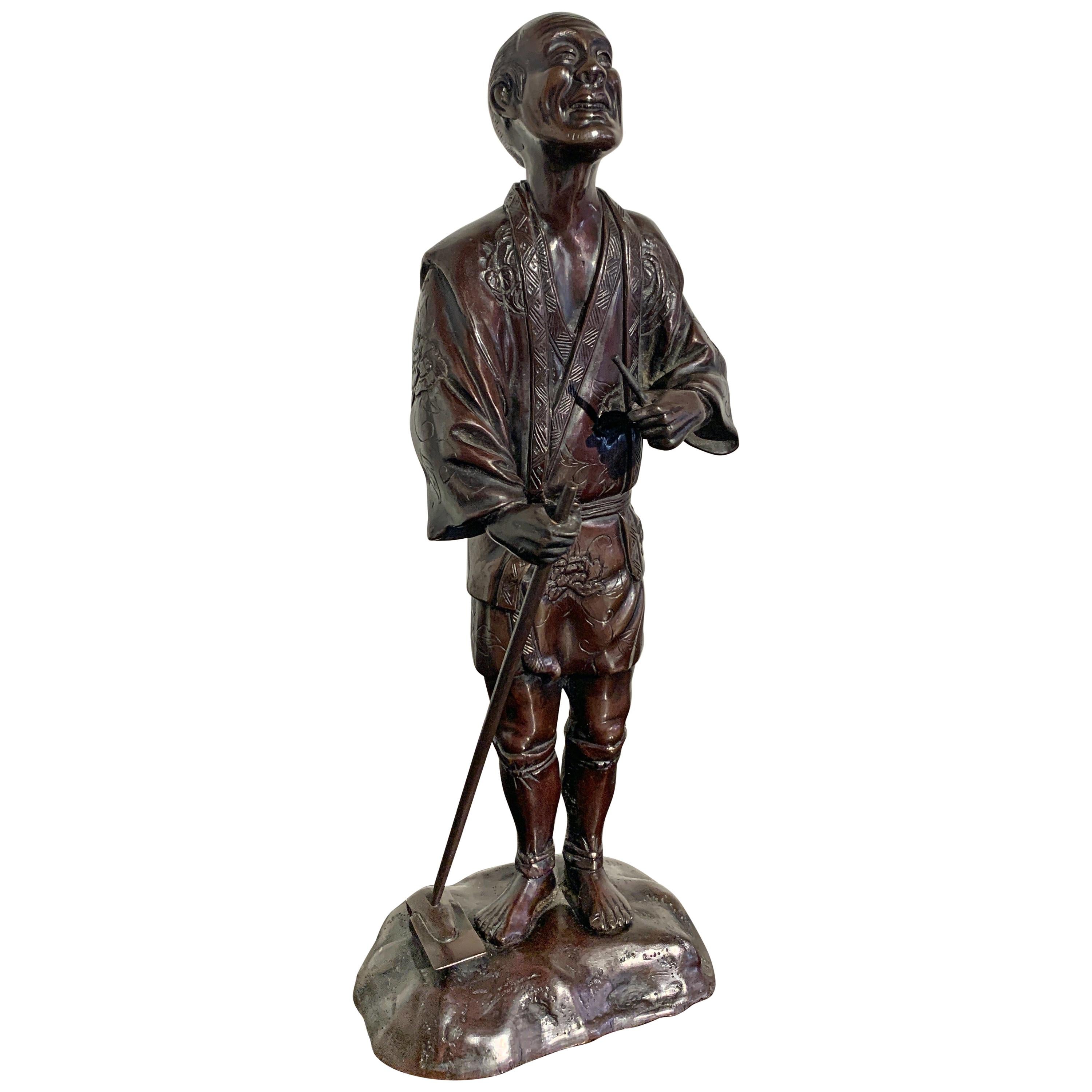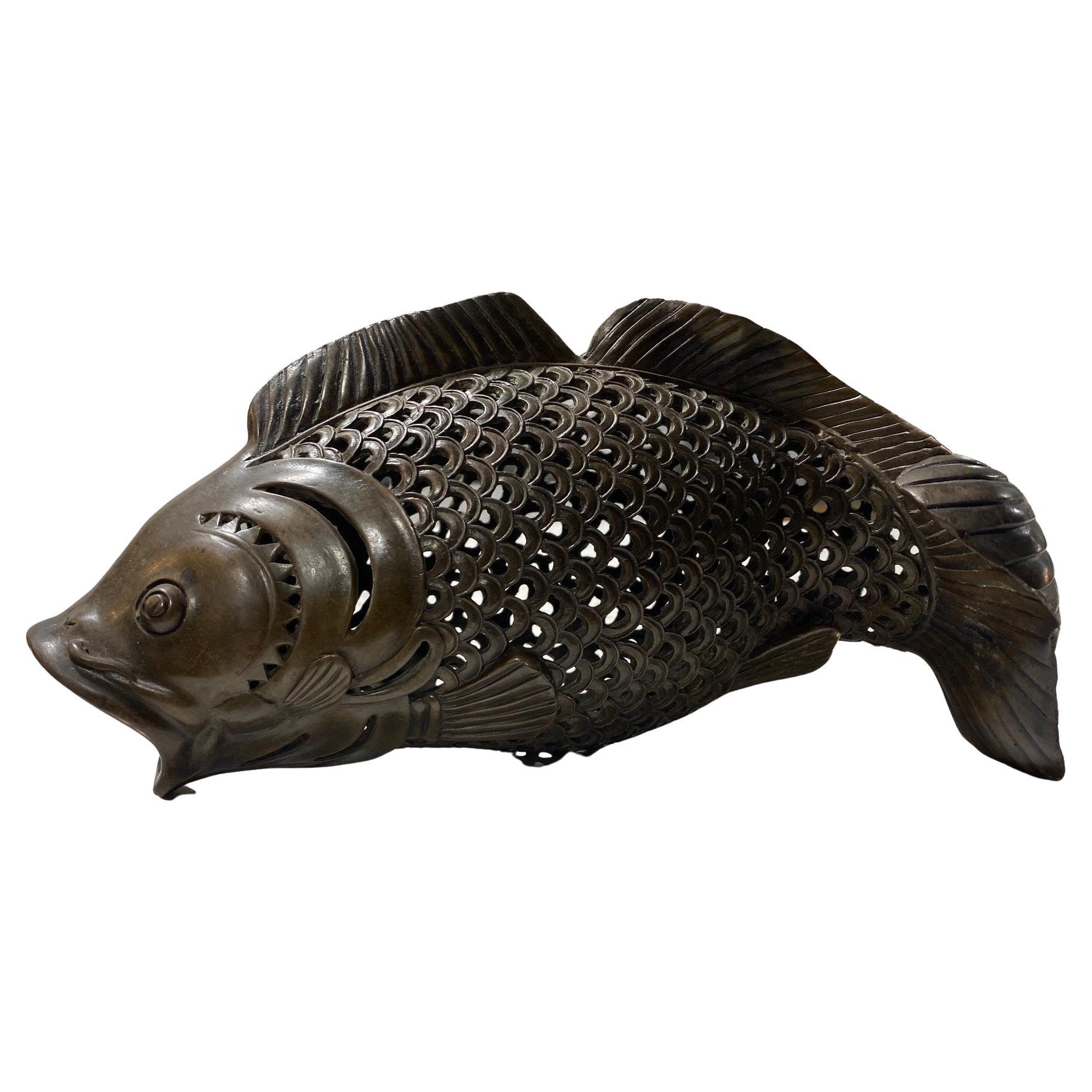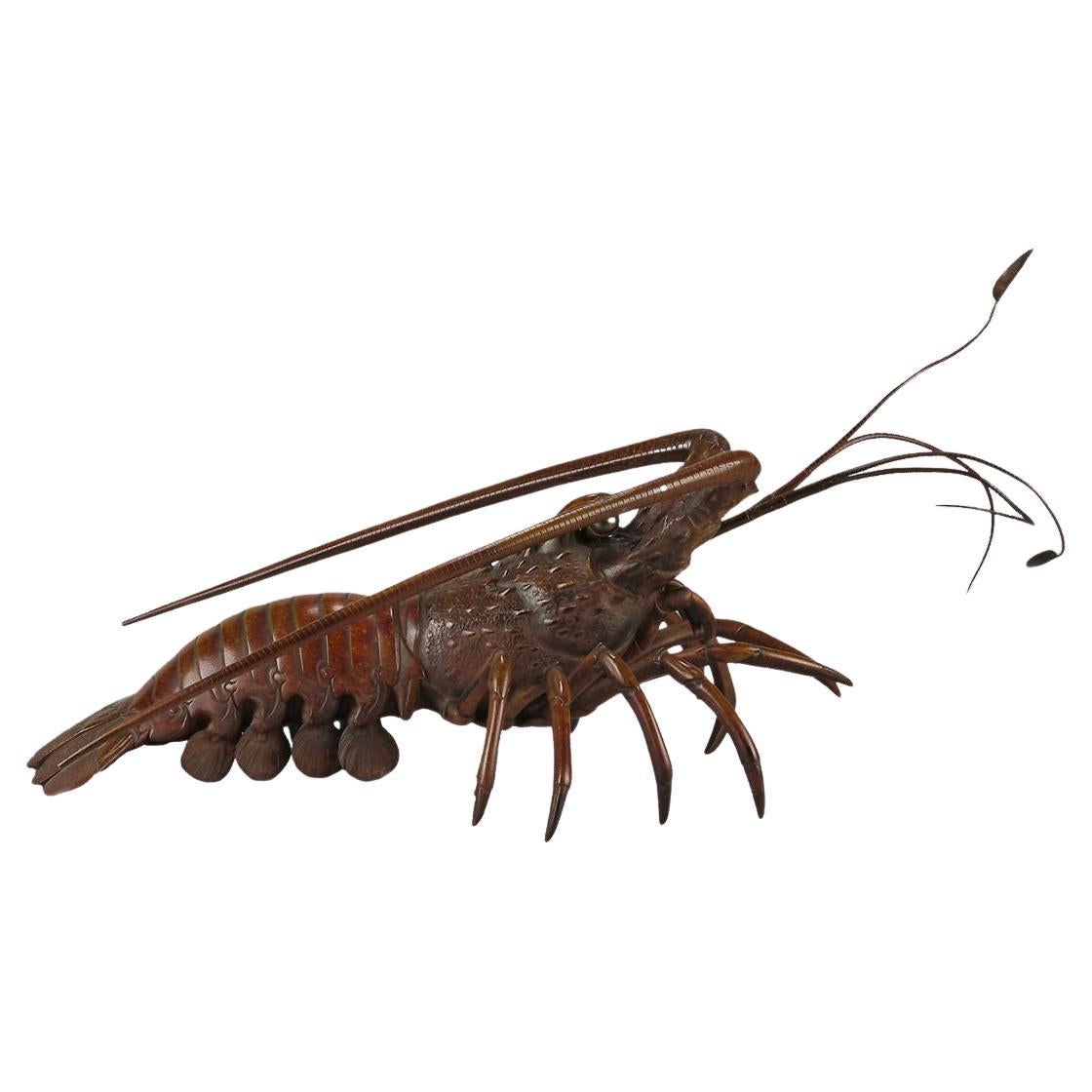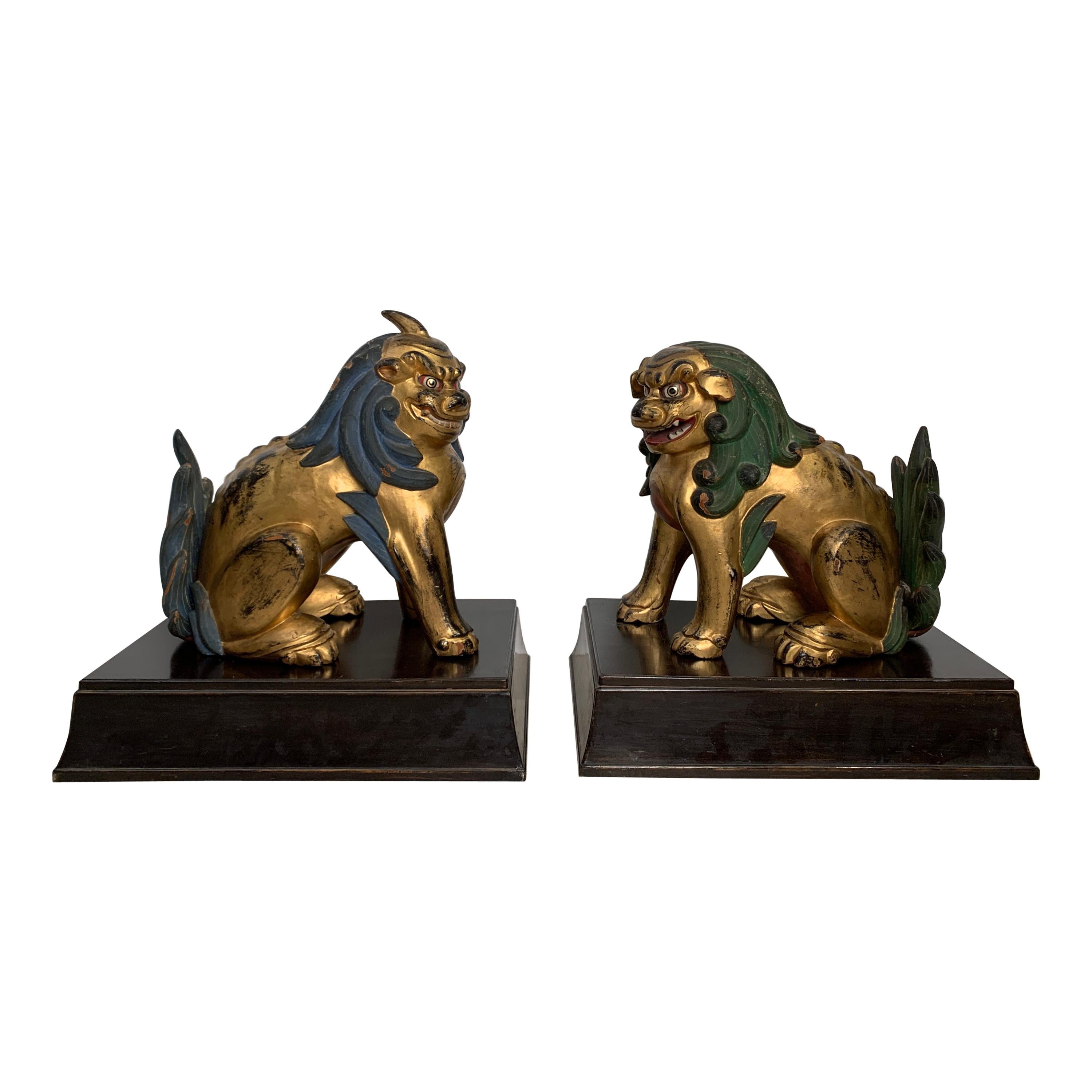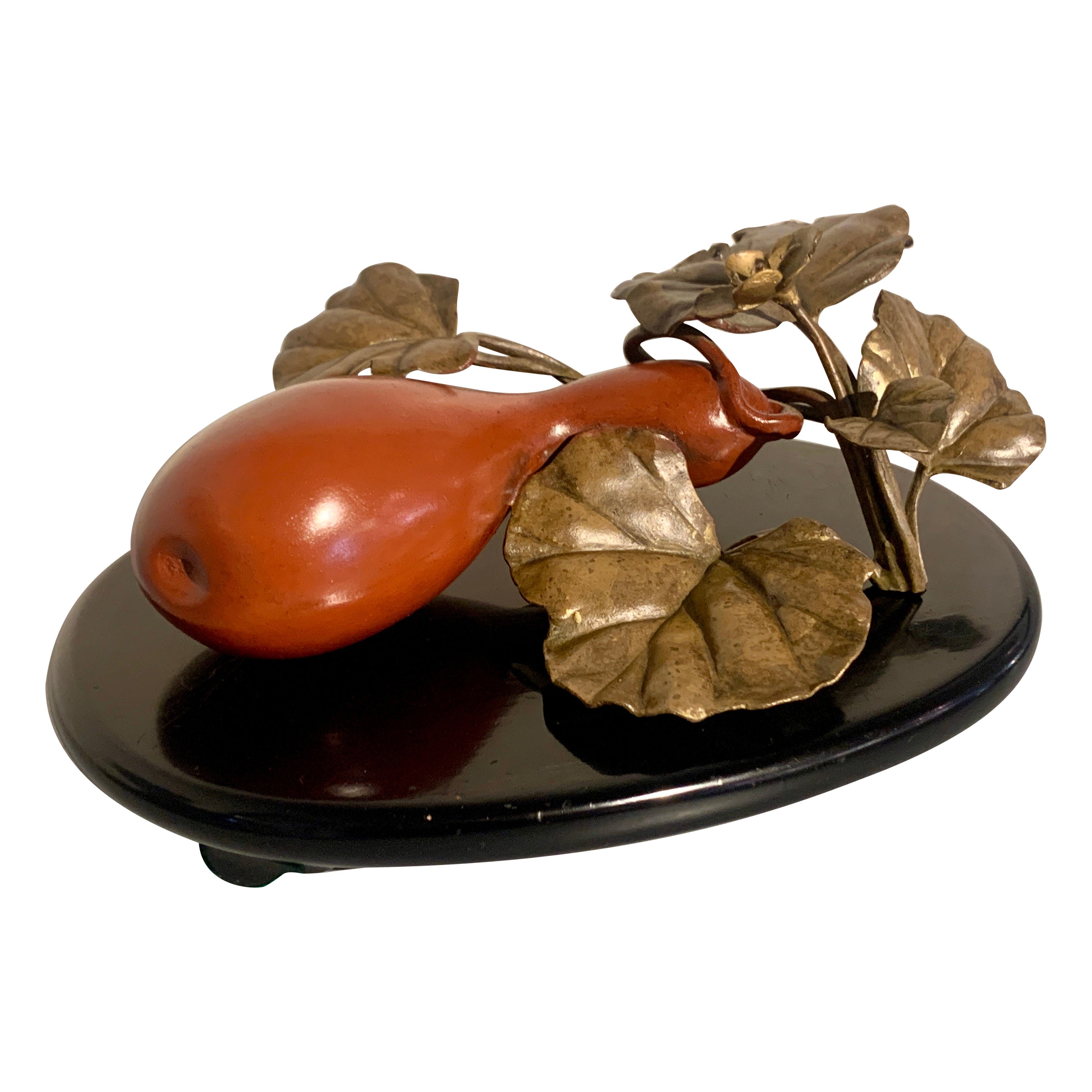Items Similar to Japanese Bronze Okimono of a Carp, Taisho Period, Early 20th Century, Japan
Want more images or videos?
Request additional images or videos from the seller
1 of 20
Japanese Bronze Okimono of a Carp, Taisho Period, Early 20th Century, Japan
About the Item
An elegant Japanese cast bronze okimono of a swimming carp, Taisho Period (1912 - 1926), early 20th century, Japan.
The graceful fish portrayed realistically in motion, as if swimming against a current. The fish's fins pushed back, muscular body taut and straining, with its tail rippling out behind. The carp's eyes look straight forward with a focused and determined gaze.
Expertly and naturalistically cast, with especially fine attention to the scales, and even the underside of the head. An artist's mark engraved to the underside.
The bronze with a beautiful mellow patina.
Carp are symbols of perseverance, strength, and determination in Japanese culture. They often swim against the current. Legend states that any carp strong and brave enough to swim up and jump over the Dragon Gate (Longmen) waterfall, instantly is transformed into a dragon.
- Dimensions:Height: 3.13 in (7.96 cm)Width: 12.5 in (31.75 cm)Depth: 4 in (10.16 cm)
- Style:Taisho (Of the Period)
- Materials and Techniques:
- Place of Origin:
- Period:
- Date of Manufacture:circa 1920
- Condition:Wear consistent with age and use. One minor casting flaw to the scales. Some light scratching to the bronze.
- Seller Location:Austin, TX
- Reference Number:1stDibs: LU894727806742
About the Seller
5.0
Platinum Seller
These expertly vetted sellers are 1stDibs' most experienced sellers and are rated highest by our customers.
Established in 2001
1stDibs seller since 2010
306 sales on 1stDibs
Typical response time: 1 hour
- ShippingRetrieving quote...Ships From: Austin, TX
- Return PolicyA return for this item may be initiated within 7 days of delivery.
More From This SellerView All
- Japanese Tokyo School Bronze Okimono of a Farmer, Meiji PeriodLocated in Austin, TXA very fine and detailed Tokyo School cast bronze okimono (decorative sculpture) of a smiling farmer, Meiji period, late 19th century, Japan. The e...Category
Antique Late 19th Century Japanese Meiji Sculptures and Carvings
MaterialsBronze
- Pair of Japanese Gilt Wood Komainu, Guardian Lions, Early 20th Century, JapanLocated in Austin, TXA charming and mischievous pair of Japanese carved, gilt and painted komainu, often mistaken for foo dogs or foo lions, Showa Period, 1920's, Japan. The two komainu, or guardian lions, are portrayed seated upon their haunches, heads slightly turned. The two beasts are well carved, with wonderful musculature, flowing manes, and bushy tails. Their faces a mix of ferocious and comical. The eyes of reverse painted glass with gilt highlights. One is a true komainu, (lion-dog), with a horn on its head, and its mouth closed. The other is a shishi, (lion), with its mouth open, and no horn. The komainu sports a mane and tail pigmented blue with gilt highlights. The shishi sports a mane and tail pigmented green with gilt highlights. Both figures richly gilt in gold lacquer. Komainu are protective beings, similar to foo lions or foo dogs...Category
Vintage 1920s Japanese Showa Sculptures and Carvings
MaterialsGlass, Cypress, Wood
- Pair Japanese Kutani Okimono of Mandarin Ducks, Showa Era, Early 20th CenturyLocated in Austin, TXA charming and delightful pair of Kutani glazed porcelain models, okimono, of Mandarin ducks, oshidori, Showa Era, circa 1930's, Japan. The two Mandarin ducks, called oshidori in ...Category
Vintage 1930s Japanese Showa Ceramics
MaterialsPorcelain
- Japanese Painted Bronze Okimono of a Gourd by Toyo, Showa Era, 1960s, JapanBy ToyoLocated in Austin, TXA charming Japanese decorative bronze sculpture, okimono, of a gourd, hyotan, by Toyo Japan, Showa Era, circa 1960s, Japan. The realistic okimono, fashio...Category
Vintage 1960s Japanese Showa Sculptures and Carvings
MaterialsBronze
- Nepalese Gilt Bronze Buddhist Figure of Manjushri, Early to Mid-20th CenturyLocated in Austin, TXA lovely Nepalese gilt bronze figure of Manjushri, the Bodhisattva of Wisdom, early to mid 20th century. The Bodhisattva of Transcendent Wisdom ...Category
Mid-20th Century Nepalese Tibetan Sculptures and Carvings
MaterialsLapis Lazuli, Bronze
- Nepalese Gilt Bronze Bodhisattva 'Amoghapasha?', Early to Mid-20th CenturyLocated in Austin, TXA beautiful and unusual gilt bronze figure of a Bodhisattva, possibly Amoghapasha, Nepal, early to mid-20th century, circa 1930s or 1940s. The regal figure possibly depicting the bodhisattva Amoghapasha, the Unfailing Lasso. The enlightened being is portrayed seated upon a high double lotus pedestal. He is dressed as an Indian prince, wearing a luxurious foliate patterned dhoti around his waist and a billowing scarf around his shoulders. . His torso bare save for the jeweled necklaces and the sacred thread. A five pointed crown with an image of Amitabha Buddha in the central point graces his head. His princely face cold painted with beautiful detail, his hair colored blue with crushed lapis lazuli, indicating his peaceful nature. Amoghapasha holds a lasso in one hand, an axe in the other. He is considered an emanation of Avalokiteshvara. A bodhisattva of compassion, Amoghapasha is so named because of the lasso he holds in his hand. The lasso represents his vast compassion which is thought to extend to encompass all beings, bringing them into a state of perfection and enlightenment. The copper base plate, seemingly a later replacement, has been inscribed with a visvajra (double vajra...Category
Mid-20th Century Nepalese Tibetan Sculptures and Carvings
MaterialsLapis Lazuli, Bronze
You May Also Like
- Early 20th Century Japanese Bronze Okimono of a "Crayfish"Located in London, GBAn eye catching Japanese Okimono bronze study of a lobster with very fine intricate hand finished surface detail and good rich brown colour, signed to underside of tail Additional information Length: 48 cm Width: 31 cm Condition: Excellent Original Condition Circa: 1910 Materials: Bronze About Japanese Okimono Okimono is a Japanese term meaning “ornament for display; objet d’art; decorative object”, typically displayed in a tokonoma “alcove” or butsudan “Buddhist altar”.The Japanese okimono compounds oku “put; place; set; lay out; assign; station; leave” and mono “thing; object; article”. The Oxford English Dictionary defines the loanword okimono, “A standing ornament or figure, especially one put in a guest room of a house”, and records the first usage in 1886 by William Anderson. Japanese okimono may be a small Japanese carving...Category
Early 20th Century Animal Sculptures
MaterialsBronze
- Japanese Asian Showa Period Bronze Koi Carp Fish SculptureLocated in Studio City, CAA beautiful Japanese bronze koi fish sculpture with wonderful mesh craftsmanship and a glowing patina. This piece may have initially been made to u...Category
20th Century Japanese Showa Sculptures and Carvings
MaterialsBronze
- Japanese Meiji Period Carved Wood Okimono Man with RabbitsLocated in Newark, EnglandThe charming figure, carved from a single piece of wood is exceptionally carved showing the male figure with humorous expression holding two Rabbits one by the ears and the second under his arm. A third Rabbit stands at the feet of the male looking up, each rabbit with a different expression. The male figure is wearing traditional Japanese attire with his hair tied back stood upon a naturalistic base. The figure dates to the Meiji Period (1868-1912) circa 1900. Notes The Rabbit is one of the 12 animals to feature in the Japanese Zodiac signs which follows the Chinese astrological system along with the Rat, Ox, Tiger, Rabbit, Dragon, Snake, Horse, Goat, Monkey, Rooster, Dog, Pig. Such division is connected with the Jupiter cycle around the Sun, which lasts about 12 years. As 2023 is the year of the Rabbit...Category
Antique Early 1900s Japanese Meiji Sculptures and Carvings
MaterialsWood
- Pair of Chinese Bronze Deity Figures, 20th CenturyLocated in Belmont, MAPair of Chinese bronze figures of deities standing on dragons. The two sculptures were made in the 20th century. They represent the Tao gods Lu Xing and Fu Xin...Category
Vintage 1980s Chinese Chinese Export Sculptures and Carvings
MaterialsBronze
- Japanese Okimono of a Shunga Lady Playing a BiwaLocated in New York, NYJapanese Heisei period wood carved okimono of a shunga lady playing a Biwa. Made during the Heisei period in circa 1990, the piece remains in remarkable vintage condition with age-ap...Category
1990s Japanese Modern Sculptures and Carvings
MaterialsWood
- Early 20th Century Pair of Chinese Wood Carving SculpturesLocated in North Miami, FLPresenting an exquisite pair of early 20th-century Chinese wood carvings that exude artistry and cultural richness. These masterfully crafted piece...Category
Early 20th Century Chinese Sculptures and Carvings
MaterialsWood
Recently Viewed
View AllMore Ways To Browse
Japanese Symbol
Japan Bronze Sculpture
Japanese Bronze Sculpture
Cast Bronze 1920
Japanese Bronze Sculptures
Taisho Period
Finial Japan
Dragon Carving
Japanese Dragon Art
Fish Carving
Dragon Scale
Carp Furniture
Muscular Sculpture
Asian Dragon Sculpture
Carved Fish Sculpture
Swimming Sculpture
Waterfall Lacquer
Gold Carved Dragon
